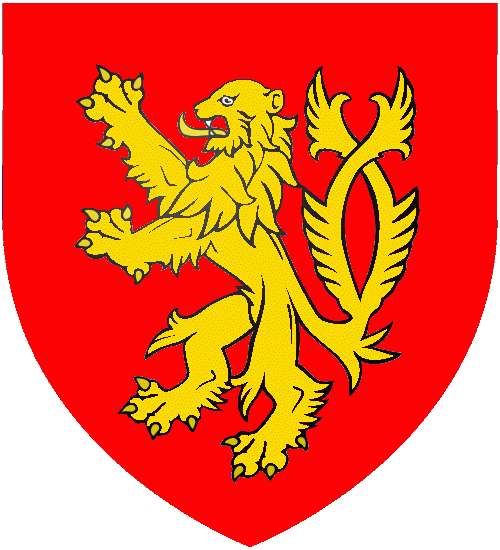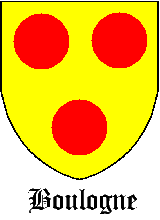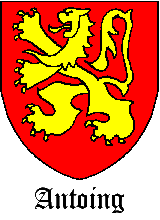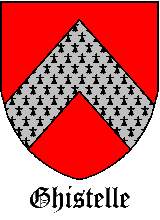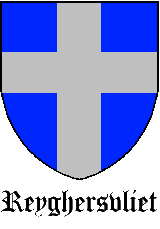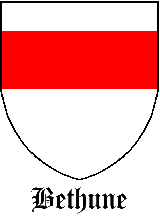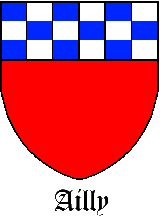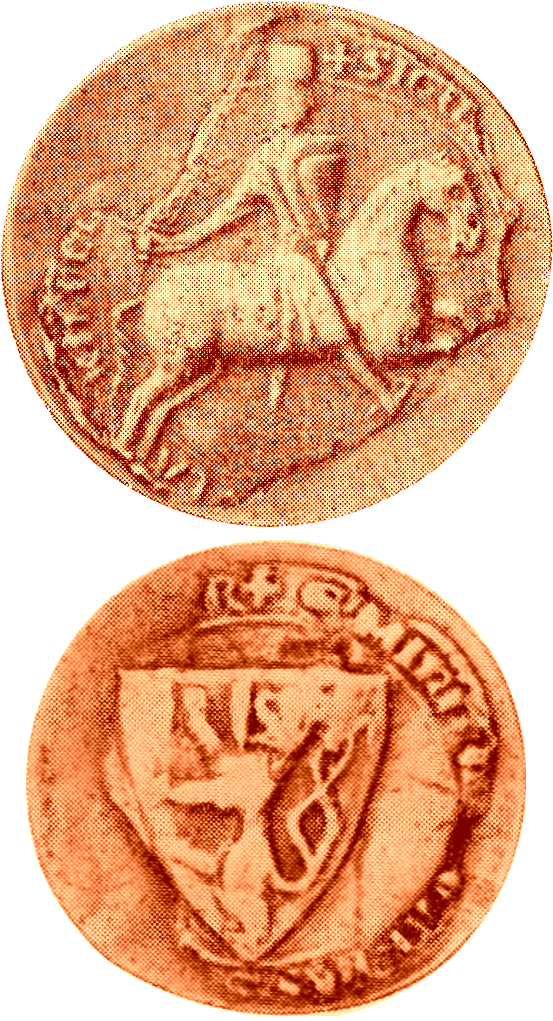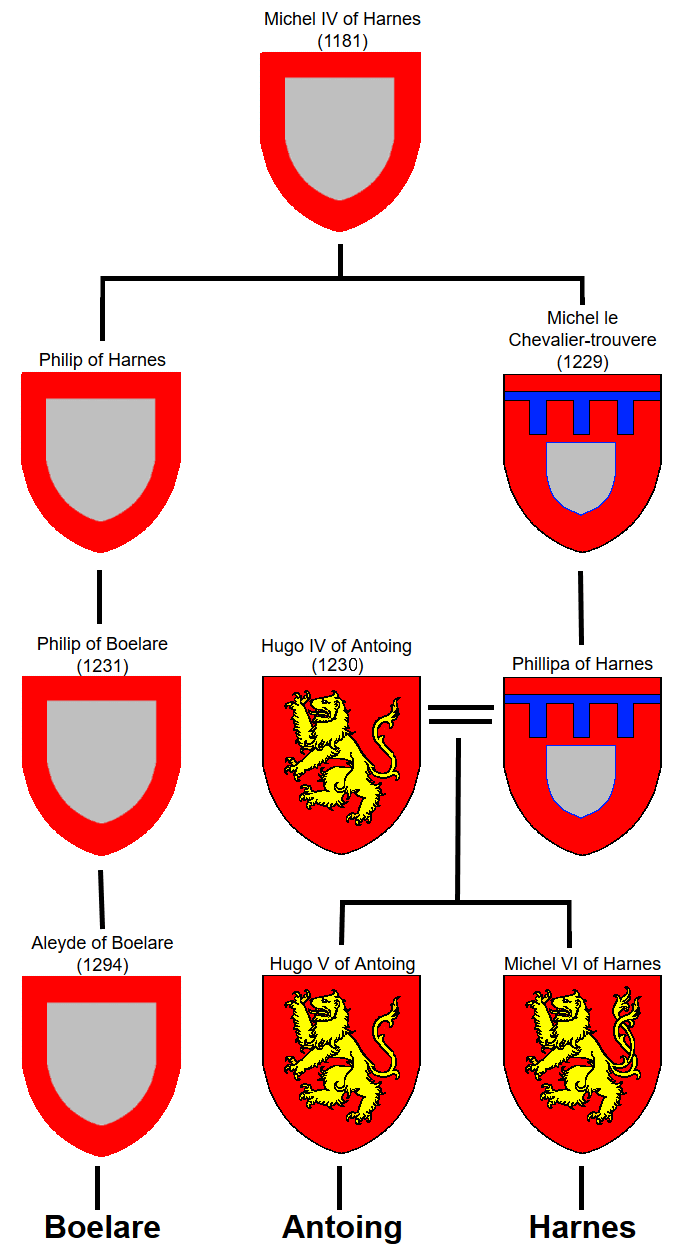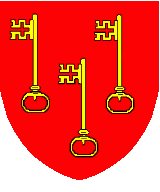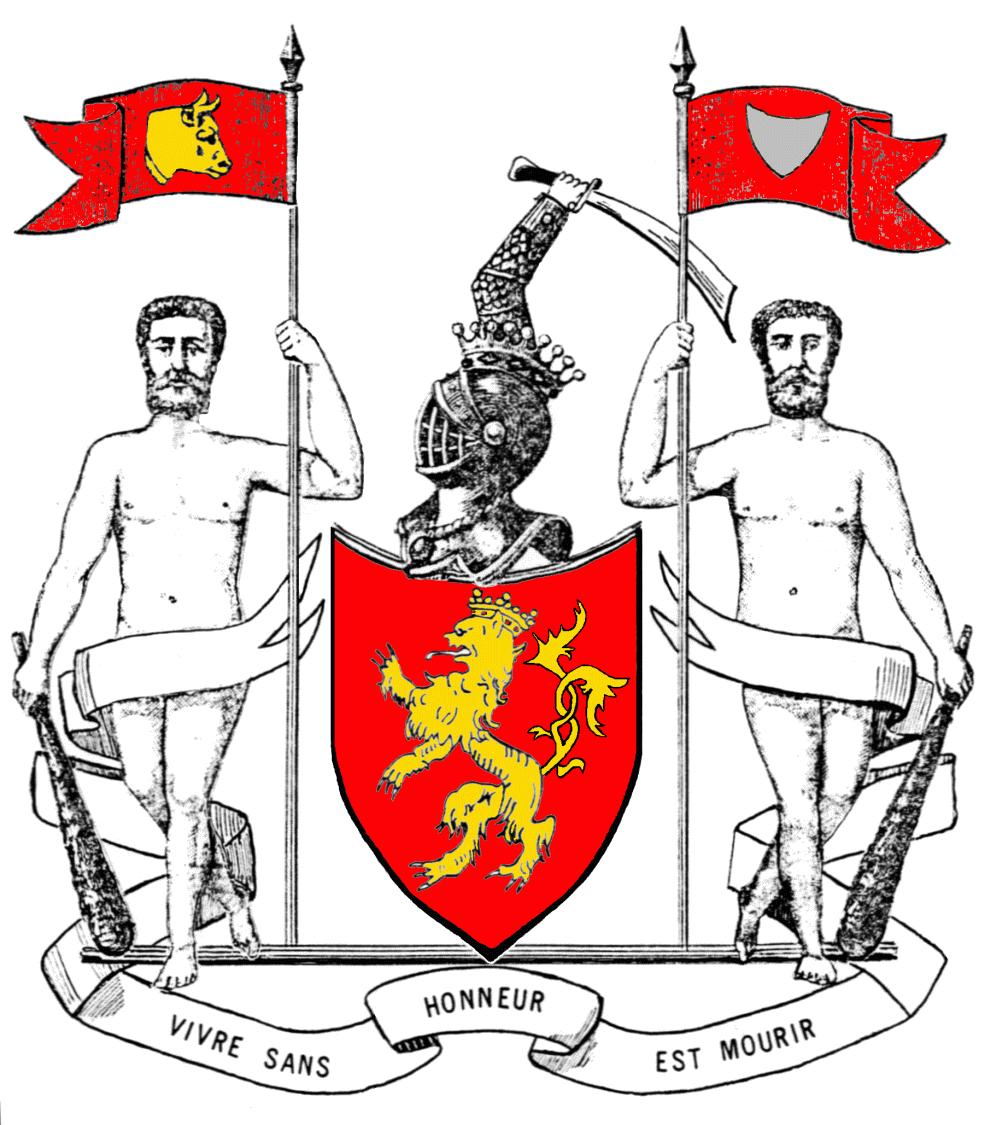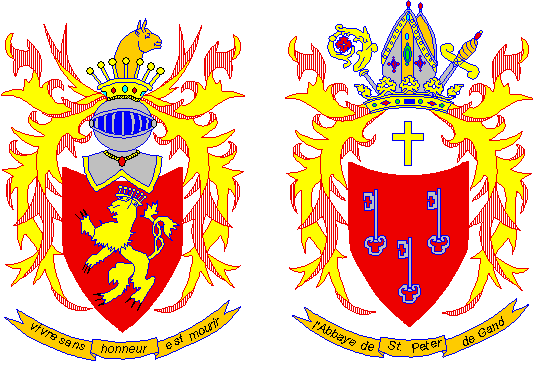|
The land of Harnes in ancient times was an expanse of wetlands and odious bogs located at the headwaters of the Deule River, a tributary of the Scheldt (Schelde) River of Belgium. In fact, the name Harnes is probably derived from harn or hearn, an old Flemish word that means a marsh or swamp. Thus, Harnes in ancient times must have been a very wet and inhospitable place. St. Martin, the much venerated Bishop of Tours, is said to have built around 383 A.D. a small chapel on some high dry ground in the land of Harnes. Martin of Tours made many converts among the people of the marshes, and a small community quickly grew up around his chapel. Although the land was ultimately overrun, and the chapel destroyed, during the Barbarian invasions of the Vth century, the village of Harnes survived and exists to this day. The bogs of ancient Harnes are gone now, the land having been drained long ago to make way for farmlands and fields. Yet prehistoric bogs, far more ancient than those that St. Martin knew, remain in the form of coal beds in the underground coal mines of nearby Courriers. The prosperity once afforded by these mines brought many newcomers to Harnes, and the town by 1975 had grown to nearly 14,000 people. Unfortunately, most of these mines are closed today, the coal seams having played out, and many families must now commute to jobs in the giant industrial city of Lille, located just a few miles to the northeast. Vikings began raiding the coasts of northern Europe in the IXth century and sailed their longboats up many rivers, including the Scheldt and Deule, in search of plunder. Entire towns were looted and burned; and the King of France, apparently powerless to stop the Norsemen, withdrew his troops, thereby abandoning the lowlands of the Scheldt to the raiders. Because the people were left to fend for themselves, the land, in essence, could be claimed by anyone able to defend it from the Vikings. In this the local nobles did well, and they created for themselves several small counties that existed, more or less, independent of the crown. Despite later attempts by the king to reclaim his old lands, these nobles lived well, prospered, and were called reguli or "small kings". The Count of Flanders, Arnold the Old, was the most powerful of these reguli, and he kept the French King at bay for many years. However, when Count Arnold died the king quickly invaded and forced the new count and his followers to once more swear allegiance the crown. Although the Abbey of St. Peters of Ghent on Mt. Blandin succeeded St. Martin’s chapel as the owner of the land of Harnes, the abbey lost its claim to these lands in the aftermath of the Norse invasions. Nonetheless, the abbey’s ownership of Harnes was reinstated in 941 by Arnold the Old, and this donation was confirmed on Jnauary 31, 972/973 by his grandson Arnold II. The abbey chose not to work the land itself but entrusted its care to the old lords who ruled Harnes as stewards of the church. These nobles called themselves the "Mayors of the Palace of St. Peters of Ghent at Harnes", and they ruled Harnes from a castle on the north bank of the Deule. The first of these mayors were the powerful counts of Boulogne and Lens. Later, around 1072, Harnes was separated from Boulogne and Lens, and these mayors became vassals to the Count of Flanders. Eventually, they were known as counts in their own right and ruled Harnes as vassals of the Count of Artois.
St. Martin's chapel and the surrounding marshlands were originally part of the ancient Roman civitate of Atrebatum (Arras), one of 115 administrative districts that composed the frontier province of Belgica Segunda. Rome ruled these lands for more than four centuries; but the Salic Franks, an invading barbarian tribe from Germany, forced the Romans out of Belgica Segunda in 406 A.D. and occupied most of the Scheldt River drainage. Although Latin was spoken throughout the province, it was quickly replaced by an ancient form of German when the Franks replaced the Romans as masters of the Scheldt. It was probably about this time that the marshes of the upper Deule became known as the land of Harnes. Most likely, "harn" is an old Frankish word that means dirty or discolored water and was used to describe any off-color liquid ranging from urine to the foul, stagnant water of a bog. With time, "harn" came to mean a marsh or bog in medieval Flemish, a language derived from the old Frankish tongue. Interestingly, the same word in medieval German, another language derived from the old Frankish tongue, came to mean urine. In addition, "tarn", a similar sounding word used in parts of England and Scotland, denotes a marsh and probably derives from the language of the Frisians, an invading Germanic tribe from across the channel who were closely related to the Franks. Consequently, the land of Harnes can loosely be translated as "the land of dirty water".
The Forester of Bruges, Baldwin Iron-arm, in the year 860 kidnapped for his bride the daughter of Charles the Bald, the Emperor of France. Charles soon forgave Baldwin, made him the Count of Flanders, and charged his new son-in-law with the defense of the northern coasts, in particular the drainage of the Scheldt River. When Count Baldwin died he was succeeded by his son Baldwin the Bald. The new count took advantage of the chaos wrought by Viking invaders and to forcefully subjugate many of the neighboring nobles, thereby making himself a margrave, which is a count who oversees a march of several counties. Baldwin’s cousin Ralph was margrave of several adjacent counties to the south of Flanders, a march that included the land of Harnes and the future county of Artois. When Ralph died in 892 Baldwin seized these lands and added them to his own march. Later, Baldwin’s lands were divided into the counties of Boulogne, Flanders, and Lens, with Harnes attached to the northern part of Lens. The succession and lineage of the Counts of Boulogne is uncertain and confusing, with few medieval documents to validate the family relationships. What follows is based largely on research by the Foundation for Medieval Genealogy, which is repeated in large part on the Racines et Histoire website (in French). The Houses of Flanders, Boulogne and Lens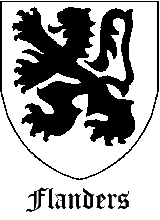
The Count of Flanders, Robert the Frisian, divided the county of Lens in 1072 into the fiefs of Lens, Harnes, and Henin-Lietard. The towns of Harnes, Annay, and Loison were included in Harnes; whereas Lens, Henin, Lietard, Noyelles, Billy, and Montigny were divided between Lens and Henin-Lietard. Later, Pont-a-Vendin, Courriers, and Cuinchy were added to Harnes. The people of Harnes were literally owned by the nobles, and the nobles themselves served as vassals to the counts of Flanders. Nonetheless, the actual land did not belong to the lords, nor to the king, but to the abbey of St. Peters of Ghent by virtue of St. Martin's ancient chapel. As such, the lords of Harnes administered this land as stewards of the abbey. Technically the Lords of Harnes were never counts, though they may at times have been called such. Rather they were mayors of the palace for the Abbey of St. Peters of Ghent, which owned the land, and they ruled Harnes as stewards of the abbey. Likewise, the land of Harnes technically was never a county. Rather it was a holding of the abbey that existed independent of the neighboring counties of Lens and Tournai. Harnes, along with Lens and Tournai, later became part of the much larger the County of Flanders, and ultimately Harnes was incorporated into the County of Artois, which today is part of modern France. The town of Harnes and many surrounding villages were reduced to rubble during battles of the First World War, with the loss of many records relating to the Counts of Harnes and Castellans of Cassel. Because some sources referenced by Pascallet (1857), Demarquette (1856, 1867), de Smyttere (1866) and others can no longer be located, a few modern researchers dispute some of the findings of these earlier authors, and cast doubt on the existence of Michel I of Harnes, Cunnegonde and others. Most of this type of research is not perfect, as it requiries interpretations of a limited body of extant original sources. However, disputing the work of researchers who died over a century ago, and had access to sources no longer available, does border a bit on arrogance, and in some cases demonstrates an ignorance of how the devastations of past wars can compromise modern historical research. (see Harnes in WWI)
The direct line of the Mayors of Harnes dies out with Michael IX of Harnes and his brother Englebert I. Although Englebert's name appears as mayor, we soon find Michel's widow Margaret of Reyghersvliet ruling the mayorality of Harnes, possibly in Englebert's name, and the mayorality with Margaret's death passes to the House of Ghistelle. This is also a time that marks the onset of the Hundred Years War (1337-1453) between France and England, a conflict in which the Lords of Ghistelle generally sided with the English.
1384 - Harnes becomes part of the Duchy of Burgundy with the death of Louis II, the last Count of Flanders. His lands then passed to his daughter Margaret of Flanders, and to Margaret's husband Philip the Bold, the Duke of Burgundy. Although Philip of Burgundy was also a younger son of the King of France, his combined Duchy of Burgundy and Flanders existed largely independent of the crown of France. Thus the Mayors of Harnes become vassals to both France and Burgundy, which led to subsequent conflicts with France when Burgundy, as with the House of Ghistelle earlier, sided with England during the later part of the Hundred Years War (1419-1453).
1458 - An argument arises between the King of France, Charles VII, and the Duke of Burgundy, Philip the Good, over the jurisdiction of the lands along the Somme River. Because the castle of Picquigny, the seat of the lords of Ailly, was among those lands in dispute, John of Ailly was forced into the conflict. As counselor and chamberlain of Charles VII, John sided with his king. This incurred the wrath of Duke Philip, who subsequently threw John into prison. Then John on September 27, 1458 sold the castle of Harnes, and the title of Mayor of Harnes for 8,500 Flemish francs to the the Abbey of St. Peters of Ghent, an act that effectively transfered control of Harnes to the abbot of St. Peters. Thus several lords, two of them allied with Burgundy, made claims at various times during this conflict to lands held in fife by John of Ailly.
1461 - Charles VII dies, and is succeeded as King of France by his son Louis IX. The new king immediately negotiated a treaty with Philip the Good of Burgundy, in which Burgundy renounced its claims to the Somme Valley. The duke then released John of Ailly from prison, and after exiling the former mayor of Harnes to the court of France, dissolved the mayorality of Harnes. Nonetheless a succession nobles, most probably descended from the old lords, continued to be named as "Seigneurs of Harnes".
1482 - Harnes becomes part of the Habsburg Empire with the death of Mary of Burgundy. Her husband Maximilian I inherits the Duchy, as well as the Low Countries, which include both Flanders and the Netherlands. Maximilian is subsequently elected Holy Roman Emperor with the 1493 death of his father Emperor Frederick III. This results in the Seigneurs of Harnes becoming vassals to both Austria and France.
1543 - Harnes becomes part of the Kingdom of the Netherlands when Charles V, the Holy Roman Emperor and son of Maximilian, unites Flanders and the Netherlands into the "Seventeen Provinces".
1556 - Flanders is claimed by both France and Spain when Charles V abdicates as Holy Roman Emperor, and his son Philip II becomes King of Spain and the Netherlands. The King of France Francis I, hoping to protect his interests in the region, solicits the nobility there for affirmations of their loyalty. The Land of Harnes is among those lands in dispute, and when the Lord of Harnes professes his allegiance to the crown of France, this act essentially makes him a vassal to both kings.
Although Englebert II was provided lands and title by King Francis, he served as vassal to both the King of France and the King of Spain. When Philip II of Spain invaded the French county of Artois in May of 1558, he found himself with his army in the vicinity of Harnes and sent a herald to Englebert requesting hospitality. However Englebert, no friend to the Spanish cause, told the herald to "say to the king that hospitality is impossible, as there is no more chateau of Harnes". He then set fire to the documents, furniture, and buildings of his manor house. When that was done, he fled to the Abbey of Saint Peters of Ghent to become a monk. Then before his death he bequeathed his lands and possessions to the abbey, thereby leaving his heir and nephew, Denys de Harne, to earn his bread by the sword. (see The Last Count of Harnes) The Spanish were able to consolidate their rule over the Low Countries, as the Scheldt drainage was called in those days, and their occupation became one of fierce oppression of any faiths that failed to follow strict Catholic doctrine. The Protestant Wars of Rebellion grew out of this intolerance, and continual warfare devastated the region for many years. Harnes, as with most of the southern Low Countries, remained Catholic, whereas the northern Low Countries of the Netherlands became largely Protestant. Harnes also remained French in its sympathies, which put the Lords of Harnes in conflict with both their Spanish overlords, and Protestant Dutch rebels to the north seeking to free themselves from Spanish oppression. 1568 - The "Eighty Years War", essentially the Dutch war for independence from King Philip II of Spain, begins when Dutch rebels oppose Spanish forces at the Battle of Dahlen.
1581 - The Low Countries - which includes the Protestant Netherlands in the north, as well as Catholic Flanders, Brabant and Limburg in the south - declare independence from Philip II of Spain with the Union of Utrecht (1879) and the subsequent Act of Abjuration (1581). Although Spain continued to claim the Netherlands, this marks the beginning of an independent Dutch Republic that in time encompassed all of the Low Countries.
Hoping to escape the wars and devastation of these uncertain times, the heirs of Denys de Harne left the land of their birth sometime in the early 1600s and settled in the area of area of Annapes (Ascq), a suburb of the city of Lille in northern France. Spain in 1648 finally recognized the independence of the Netherlands with the Peace of Munster, and the Eighty Years War came to an end. Although the Netherlands were Protestant, the Catholic provinces of Flanders, Brabant and Limburg (essentially the southern Low Countries) were ceded to the Netherlands as part of the treaty. 1789 - The Netherlands in 1789 were annexed by the French Republic as a consequence of the French Revolution, and the new government on November 2, 1789 passed a law that stripped the Abbey of St. Peters of Ghent of its lands and wealth. The land of Harnes was then broken up into parcels in 1792 and sold, primarily to farmers who had previously leased the land from the abbey. When the Kingdom of the Netherlands was restored many years later, the land remained with the farmers and was not restored to the abbey.
The descendants of Denys de Harnes ultimately settled in Ypres, which today is part of Belgium. They prospered and generally served as government magistrates and officers, continuing in similar capacities when Ypres in 1830 became part of the newly created Kingdom of Belgium.
There is also record of a seigniory of Harnes that was a feudal fief separate and distinct from the County of Harnes. This seigniory was not located near Harnes itself, but some distance away at the village of Rumes, near the modern border between Belgium and France. This fief at Rumes originally belonged to the Abbey of St. Winnoc at Bergues, by an arrangement that was probably similar to the donation of the Land of Harnes on January 31, 972/973 to the Abbey of St. Peter's of Ghent. However, the Rumes donation by the year 1200 was no longer part of St. Winnoc's, but was owned outright by Michel V of Harnes, the knight-trouvere. The name of Harnes from that point on is associated with the fief at Rumes. This seigniory of Harnes at Rumes in 1526 came under control of the House of Beaufremez and later passed to the House of Stappens, who held it until the French Revolution. Then in the late 1600s a second seigniory of Harnes appears, this one held by the House of Dubois, and possibly located in or adjacent to the former County of Harnes. (see Sires and Seigneurs of Harnes)
The constable, or the "count of the stables", was an office that began in the early days of Flanders as the commander of the count’s cavalry, but later this position evolved into that of a military commander-in-chief. When Thierry (Theodoric) of Alsace became the Count of Flanders in 1127 after a long and bitter civil war, he assigned the offices at his disposal to lords who had served with him on the battlefield. Thus we see that the following year the office of constable was awarded to his trusted ally Michel III of Harnes. The constable prior to Michel's appointment served at the whim of the count, but from Michel's time on it became a hereditary position that was generally held by members of the House of Harnes. 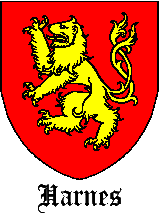
Philip II left no male heirs and, although it is not stated, it seems probable that the office of constable passed to his son-in-law, Razo VIII of Liederkerke (d. 1306/1308). Because Razo was Philip’s successor to the Peerdom of Boelare, his ascension to the office of constable becomes even more probable when we learn that in 1295 his son, Razo IX (d. 1323), is both Peer of Boelare and standard bearer of Flanders. Apparently, the standard bearer in earlier times was also the constable. Most likely, the responsibilities of the constable were separated after the death of Razo VIII, with Razo IX becoming the standard bearer and Razo’s cousin Michel VIII of Harnes becoming the new constable.
Michel IX of Harnes died sometime between 1330 and 1340, most likely a victim of the Black Plaque or the Hundred Years War between France and England. After his death, the direct line of the Mayors of Harnes dies out, and it is difficult to ascertain what happens to the office of constable. Possibly, it passed to the house of Antoing, a Flemish family closely related to the lords of Harnes. These nobles, as Viscounts of Ghent, were castellans of Gravensteen, a mighty castle located in Ghent on the banks of the Scheldt River. Because this stronghold was the mightiest fortress in Flanders, as well as the primary residence of the counts of Flanders, its castellans were essentially the chief military officers of Flanders and second in power only to the Count himself. The House of Ghistelle, which inherited the lands of Harnes from the Antoing family, was sympathetic to the English cause, and it seem unlikely that the Count of Flanders, who at the time supported France, would have allowed the lords of Ghistelle to become the constables of Flanders. When a constable reappears in the French court a hundred years later, he is one the lords of Antoing.
Several members of the House of Harnes were castellans, or castle-keepers. The first stronghold associated with the family is the castle of Harnes, which was built sometime between 920 and 960, probably by Count Arnold I of Flanders, on a low hill in the land of Harnes, possibly the same site that once held St. Martin’s chapel. Shops and houses sprang up around this fortress, and today the same site is the central square of the town of Harnes. Later, the castle became a French fortress, and it was looted and burned in 1303 or 1304 by the Flemish during a revolt. It was attacked again in 1479 and 1486, probably first by Burgundian, and then later by Austrian forces. The castle remained in French hands until 1493 when Maximillian, the Habsburg Emperor of Austria, had it burned and dismantled during a war with France. The Mayors of Harnes also served the Counts of Flanders as castellans of Cassel, another fortress located just a days ride to the north of Harnes. Michel III, the constable of Count Thierry of Flanders, is mentioned in 1139 as the castellan, but he may have inherited the castle at an earlier date. Cassel remained in the family until 1218 when Michel II of Boelare (V of Harnes) sold it to Countess Joan of Flanders. Below is a list of the castellans of Cassel, with names and dates from an 1866 history on Cassel by de Smyttere.
Three nobles related to the House of Harnes were castellans of Gravensteen, a great Flemish castle that was once the primary residence of the Counts of Flanders. The fortress of Gravensteen stands to this day in the old city center of Ghent, where it is surrounded by a moat. The names of these castellans are listed below.
There existed in Flanders several powerful lords, among them the sires of Boelare, who were known as the peers of Flanders. Because the peers controlled castles along the frontiers of Flanders, they formed the first line of defense along the county borders- a responsibility that entitled them to certain powers not enjoyed by other vassals to the Count of Flanders. For example, the peers formed a court able to pass sentence on the count, and it was their duty to choose a new count if the old count died without an heir. Thus, the college of the peers formed a check on the power of the count, and collectively they were considered his equals. 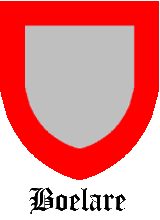
The lands of Boelare passed to the House of Harnes in 1323 after the death of Razo IX. When Flanders in 1389 became part of the Duchy of Burgundy, the Flemish peerdoms became meaningless positions.
Several of the lords of Harnes participated in the Crusades. Either Michel I or Michel II probably followed their cousins, Godfrey of Bouillon and/or Baldwin II of Boulogne, on the First Crusade (1096-1099). Later Michel III of Harnes was the constable of Thierry of Alsace, and he probably followed Thierry when Thierry initiated the Second Crusade (1147-1149). Michel V of Harnes, the Knight-trouvere followed Baldwin IX of Flanders on the conquest of Constantinople during the Fourth Crusade (1202-1204), and he became a French hero in 1214 at the battle of Bouvines, which was fought on French soil following the Crusade. Michel VI of Harnes and/or his son Hugh I followed King Louis IX (St. Louis) of France on at least one of his crusades (1250 or 1270).
Because knights of the XIIth century usually rode into battle with their family emblems emblazoned on their shields, these emblems became known as "arms". Later, knights of the XIIIth century embroidered their arms on the surcoats they wore over their chainmail armor. Hence, these hereditary insignia became known as "coats of arms". The first known use of a coat of arms by a member of the House of Harnes was by Michel IV during the later part of the XIIth century. His arms, which are shown as his seal above and left, consist of a silver shield of pretence on a red field. These same arms were displayed by his sons. The eldest son, Philip of Boelare, assumed arms identical to his father; while the younger son, Michel V of Harnes, le Chevalier-trouvere, differentiated his arms by placing a label of six points above a shield of pretence. Philip’s descendants adopted variations of the silver shield of pretence on a red field, and this design became the arms of the House of Boelare. As tradition demanded, the descendants of Michel V assumed different arms. Phillipa of Harnes was the sole heir of Michel V and married Hugh IV of Antoing. Phillipa’s eldest son, Hugh V of Antoing, assumed the arms of his father, a gold rampant lion on a red field. Michel VI of Harnes, the younger son, differentiated his arms from those of his brother by placing a double tail on the lion and crossing the tail in saltire. Thereafter, the lords of Harnes displayed a rampant lion with double tail crossed in saltire, while the lords of Antoing displayed a rampant lion with single tail. The seal of Michel VII of Harnes, son of Michel VI, are shown below and left, and they clearly display the double tail on the lion. The evolution of the arms displayed by various members of the House of Harnes is shown below
revised April 6, 2019
| ||||||
 History of the Counts of Harnes
History of the Counts of Harnes 
